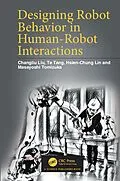In this book, we have set up a unified analytical framework for various human-robot systems, which involve peer-peer interactions (either space-sharing or time-sharing) or hierarchical interactions. A methodology in designing the robot behavior through control, planning, decision and learning is proposed. In particular, the following topics are discussed in-depth: safety during human-robot interactions, efficiency in real-time robot motion planning, imitation of human behaviors from demonstration, dexterity of robots to adapt to different environments and tasks, cooperation among robots and humans with conflict resolution. These methods are applied in various scenarios, such as human-robot collaborative assembly, robot skill learning from human demonstration, interaction between autonomous and human-driven vehicles, etc.
Key Features:
- Proposes a unified framework to model and analyze human-robot interactions under different modes of interactions.
- Systematically discusses the control, decision and learning algorithms to enable robots to interact safely with humans in a variety of applications.
- Presents numerous experimental studies with both industrial collaborative robot arms and autonomous vehicles.
Autorentext
Changliu Liu is an assistant professor in the Robotics Institute at Carnegie Mellon University, where she leads the Intelligent Control Lab. She received her PhD degree from University of California at Berkeley in 2017. Her research interests include: robotics and human-robot interactions, control and motion planning, optimization and optimal control, multi-agent system and game theory, design and verification of safe intelligent systems.
Te Tang received his PhD degree from University of California at Berkeley in 2018. He joined FANUC America Corporation in 2018, and he is currently a researcher at FANUC Advanced Research Laboratory. His research interests include robotics, learning from demonstration, computer vision and their industrial applications.
Hsien-Chung Lin is a research engineer in FANUC Advanced Research Laboratory at FANUC America Corporation. Prior to joining FANUC, he received his Ph.D. degree from University of California at Berkeley in 2018. His research interests cover robotics, optimal control, human-robot interaction, learning from demonstration and motion planning.
Masayoshi Tomizuka received his PhD degree from MIT in 1974. In 1974, he joined the Mechanical Engineering Department of the University of California, Berkeley, where he currently is Cheryl and John Neerhout, Jr., Distinguished Professor. His research interests are control theory and its applications to mechatronic systems such as robots. He is a Life Fellow of ASME and IEEE, and a Fellow of IFAC. He was awarded the Rufus Oldenburger Medal (2002) and the Richard Bellman Control Heritage Award (2018).
Inhalt
Table of Contents
SECTION I INTRODUCTION Introduction Human-Robot Interactions: An Overview Modes of Interactions Robot Behavior System Design Objectives System Evaluation Outline of the Book
Framework Multi-Agent Framework Agent Behavior Design and Architecture Conclusion
SECTION II THEORY
Safety during Human-Robot Interactions Overview Safety-Oriented Behavior Design Safe Set Algorithm Safe Exploration Algorithm An Integrated Method for Safe Motion Control Conclusion
Efficiency in Real-Time Motion Planning Overview Problem Formulation Optimization-Based Trajectory Planning Optimization-Based Speed Profile Planning Optimization-Based Layered Planning Conclusion
Imitation: Mimicking Human Behavior Overview Imitation for Prediction Imitation for Action Conclusion
Dexterity: Analogy Learning to Expand Robot Skill Sets Overview Concept of Analogy Learning Advantages of Analogy Learning Structure Preserved Registration for Analogy Learning Experimental Study Conclusion
Cooperation: Conflict Resolution during Interactions Overview Dynamics of Multi-Agent Systems Cooperation under Information Asymmetry Conflict Resolution through Communication Conclusion
SECTION III APPLICATIONS
Human-Robot Co-existence: Space-Sharing Interactions Overview Robot Safe Interaction System for Industrial Robots Robustly-Safe Automated Driving System Conclusion
Robot Learning from Human: Hierarchical Interactions Overview Remote Lead Through Teaching for Implementing Imitation Learning Robotic Grasping by Analogy Learning Robotic Motion Re-planning by Analogy Learning Conclusion
Human-Robot Collaboration: Time-Sharing Interactions Human-Robot Collaboration in Manufacturing Safe and Efficient Robot Collaborative System Experimental Study Conclusion
SECTION IV CONCLUSION
Vision for Future Robotics and Human-Robot Interactions Roadmap to the Future Conclusion of the Book
References
Index
